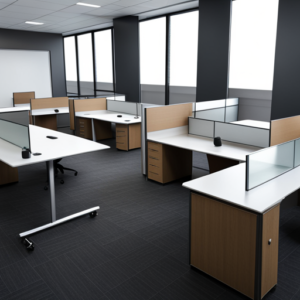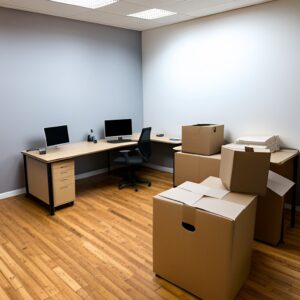We understand that office relocations in Dublin can be a daunting and stressful task for businesses. However, with the right planning and assistance, moving your office can be a smooth and hassle-free experience.
In Dublin, there are expert moving services available to make your office relocation stress-free and efficient.
Why Office Relocations Dublin are important for businesses
Office relocations are an essential part of a business’s growth and expansion. Here are a few reasons why office relocations are important:
Expansion: Moving to a larger office space allows businesses to accommodate their growing team and resources. It provides room for expansion and enhances productivity.
Upgrade: Relocating to a better facility can provide improved infrastructure, modern amenities, and a more professional environment, benefiting both employees and clients.
Cost savings: Moving to a more affordable location or negotiating better lease terms can help businesses save on rent, utilities, and other operational costs.
Accessibility: Choosing a strategic location with easy access to transportation, amenities, and potential clients can significantly improve business opportunities.
Benefits of a stress-free office move
Moving your office can be a stressful process, but with professional assistance, it can be a smooth and efficient transition. Here are the benefits of a stress-free office move:
Minimized downtime: With proper planning and organization, a stress-free office move ensures minimal disruption to your business operations. It allows your team to resume work quickly and reduces the loss of productivity.
Professional handling: Expert office relocation services in Dublin can handle the entire process, from packing and transporting equipment to setting up the new office space. Their experience ensures that your equipment and furniture are safely handled and installed in the new location.
Efficient organization: Professional office relocation services provide detailed planning and organization, ensuring that everything is moved systematically. They can help with inventory management, labeling, and packing, making the unpacking process much more streamlined.
Reduced risk of damage: With trained professionals handling your office move, there is a reduced risk of damage to your equipment and assets. They have the necessary tools and expertise to handle delicate and valuable items safely.
Peace of mind: By outsourcing your office relocation to professionals, you can focus on your core business activities while knowing that the move is being handled efficiently. This peace of mind allows you to transition smoothly into your new office space.
Office relocations in Dublin can be stress-free and seamless if you choose to work with reliable and experienced service providers. Their expertise ensures that your move is efficient, organized, and completed with minimal disruption to your business operations.

Planning the Office Relocation
When it comes to office relocations in Dublin, proper planning is essential to ensure a smooth and stress-free transition.
Here are some key steps to consider when planning your office move:
Creating a detailed timeline and checklist
• Start Early: Begin the planning process as early as possible, ideally several months before the move date. This will give you enough time to organize and coordinate all the necessary tasks.
• Make a Checklist: Create a comprehensive checklist that outlines all the activities and tasks that need to be completed before, during, and after the move. This will help you stay organized and ensure that nothing is overlooked.
• Assign Responsibilities: Delegate specific tasks to members of your team to ensure that everyone is clear on their responsibilities and the timeline for completion.
• Notify Stakeholders: Inform your employees, clients, vendors, and other relevant stakeholders about the upcoming move. Provide them with the relevant information, such as the new address and contact details.
Choosing the right moving company
• Research and Compare: Spend time researching and comparing different moving companies in Dublin. Look for companies with experience in office relocations and positive reviews from previous clients.
• Get Multiple Quotes: Request quotes from multiple companies to compare prices and services offered. Consider factors such as insurance coverage, packing materials provided, and any additional services offered.
• Check for Licenses and Insurance: Ensure that the moving company you choose is properly licensed and insured. This will give you peace of mind knowing that your office equipment and belongings are protected during the move.
• Discuss Logistics: Have a detailed discussion with the moving company to discuss logistics, such as the timeline, packing requirements, and any specialized equipment needed for the move. Clarify any questions or concerns you may have.
Evaluating the new office space and layout
• Measure and Plan: Before the move, visit the new office space and take measurements. This will help you determine the layout and plan for the placement of furniture, equipment, and workstations.
• Consider Workflow: Take into account the workflow and needs of your team when designing the new office layout. Create a space that promotes productivity and collaboration.
• Optimize Storage: Evaluate the storage options in the new office space and determine if any additional storage solutions are needed. This will help keep the workspace organized and clutter-free.
• Consider Ergonomics: Pay attention to ergonomics when selecting furniture and setting up workstations. Provide ergonomic chairs, adjustable desks, and other equipment that will support the health and well-being of your employees.
Packing and Organizing
Tips for efficient packing and labeling
Packing and labeling are essential steps in ensuring a smooth office relocation. Here are some tips to make the process efficient and organized:
- Start early: Begin packing non-essential items well in advance to avoid last-minute stress.
- Create an inventory: Make a list of all the items that need to be packed and organize them by category or department.
- Use proper packing materials: Invest in quality packing boxes, bubble wrap, packing tape, and labels to protect your office items during the move.
- Label boxes clearly: Clearly label each box with its contents and destination location in the new office space. This will make unpacking easier and help prevent misplaced items.
Organizing furniture, equipment, and files
When it comes to organizing furniture, equipment, and files during an office relocation, here are some tips to consider:
- Create a floor plan: Before moving day, create a floor plan of the new office space and designate areas for specific furniture and equipment.
- Coordinate IT relocation: If you have IT equipment, consult with your IT team or hire professionals to handle the careful disconnection and reconnection of computers, servers, and other electronic devices.
- Pack files strategically: Invest in file boxes or folders to keep files organized and easily accessible during and after the move. Consider digitizing files to reduce the amount of physical paperwork.
Ensuring the safety and security of office items
The safety and security of your office items are crucial during a relocation. Here are some measures to take to ensure everything arrives at the new location intact:
- Hire professional movers: Consider hiring professional office movers who have experience in handling office relocations. They will have the necessary equipment and expertise to transport your office items safely.
- Insure valuable items: If you have valuable equipment or furniture, consider insuring them during the move to provide extra protection in case of damage or loss.
- Coordinate with building management: Inform the building management at both your current and new location about the move to ensure a smooth transition and compliance with any specific moving regulations or requirements.
IT and Technology Considerations
When planning an office relocation in Dublin, it’s essential to consider your IT and technology needs to ensure a smooth transition.
Migrating and setting up IT infrastructure
• Assess your current IT infrastructure: Before the move, evaluate your existing IT hardware, software, and network infrastructure. This assessment will help you determine what needs to be migrated or upgraded during the relocation process.
• Plan the relocation of servers and equipment: If you have on-premises servers or other essential IT equipment, develop a plan for relocating them to the new office space. Coordinate with professional IT technicians to ensure a secure and seamless transfer.
• Establish a timeline for system downtime: Minimize disruptions to your business by planning for system downtime during the move. Inform employees and clients about any temporary service interruptions and provide alternative means of communication.
Transferring internet and phone services
• Notify your internet and phone service providers: Inform your service providers well in advance about the office relocation. Coordinate with them to transfer your existing services to the new location promptly.
• Test connectivity in the new office: Before the move, ensure that you have a stable internet connection in the new office. Test both wired and wireless connections to ensure employees can access the internet and business applications without interruption.
• Update contact information: Notify clients, suppliers, and partners about your new address and contact information. Update your website, email signatures, and other relevant communication channels to reflect the changes.
By considering these IT and technology aspects during your office relocation in Dublin, you can minimize downtime, ensure a smooth transition, and continue serving your clients and customers without interruptions.

Communication and Employee Support
Keeping employees informed and involved
During the office relocation process, it’s crucial to keep employees informed and involved to minimize stress and confusion. Here are some strategies to ensure effective communication:
1. Regular Updates: Provide regular updates to employees about the relocation process, including timelines, milestones, and any changes or updates. This can be done through email updates, team meetings, or a dedicated relocation communication channel.
2. Open Dialogue: Encourage employees to ask questions or voice their concerns about the relocation. Create an open and safe environment where employees feel comfortable sharing their thoughts and ideas.
3. Employee Briefings: Conduct employee briefings to provide detailed information about the relocation, including the reasons behind the move, the new office location, and any changes in work processes or procedures.
Providing resources and support during the move
Moving to a new office can be a daunting process for employees. To ensure a smooth transition, provide resources and support to help employees adapt to the changes:
1. Employee Resource Guide: Create an employee resource guide that includes information about the new office location, transportation options, nearby amenities, and other relevant details. This guide will help employees familiarize themselves with the new surroundings.
2. Training and Orientation: Provide training and orientation sessions to help employees get acquainted with the new office layout, equipment, and technologies. This will ensure a seamless transition and minimize any potential disruptions to their work.
3. Employee Assistance Programs: Offer employee assistance programs that provide resources and support for any personal or emotional challenges employees may face during the relocation process. This could include access to counseling services or assistance with relocation-related expenses.

Furniture Setup and Office Design
Planning the layout and design of the new office
When it comes to office relocations in Dublin, the furniture setup and office design play a crucial role in creating a productive and comfortable work environment. Here are some considerations to keep in mind:
- Start by creating a floor plan that maximizes space utilization and promotes efficient workflow.
- Consider the needs and preferences of your employees, such as the proximity of teams, access to natural light, and noise levels.
- Choose furniture that is ergonomic, functional, and aesthetically pleasing. Invest in adjustable desks, ergonomic chairs, and proper lighting to enhance employee well-being and productivity.
Setting up workstations, meeting rooms, and common areas
When setting up workstations, meeting rooms, and common areas in your new office, keep the following tips in mind:
- Arrange workstations in a way that allows for collaboration and easy communication between team members.
- Designate specific areas for meetings, brainstorming sessions, and relaxation, ensuring that they are equipped with the necessary furniture and equipment.
- Create comfortable and inviting common areas where employees can take breaks, socialize, and recharge.
Considerations for ergonomics and employee well-being
Promoting employee well-being is essential for productivity and satisfaction. Consider the following factors:
- Provide employees with ergonomic chairs, adjustable desks, and proper equipment to reduce the risk of musculoskeletal disorders and increase comfort.
- Incorporate elements of biophilic design, such as plants and natural lighting, to improve mood, focus, and overall well-being.
- Create a designated space for wellness activities, such as a meditation or relaxation room, to support mental health.
By carefully considering the layout and design of your new office, you can create a productive and welcoming environment that promotes employee well-being and contributes to the success of your business.
Testing and Maintenance
Checking and testing all systems and equipment
Before finalizing your office relocation in Dublin, it is essential to conduct thorough testing and maintenance to ensure that all systems and equipment are in working order.
Here are some key steps to follow:
Electrical Systems: Verify that all electrical outlets, switches, and wiring are functioning correctly. It’s crucial to ensure that there are no electrical faults or safety hazards in the new office space.
Telecommunication Systems: Test all phone lines, internet connections, and network infrastructure to guarantee seamless communication during and after the move. Set up a time with the service providers to install and test the systems in advance.
IT Equipment: Check the functionality of computers, printers, scanners, and other IT equipment. Make sure all software and hardware installations are complete and functioning properly.
Security Systems: Test the security alarm systems, CCTV cameras, and access control measures to ensure the safety and protection of the new office space. Coordinate with security providers to update any necessary information and passwords.
HVAC Systems: Assess the heating, ventilation, and air conditioning systems to ensure they are operating efficiently. Verify that the temperature and airflow can be regulated to provide a comfortable working environment.
Furniture and Fixtures: Inspect all furniture, fittings, and fixtures for any damage or issues that may have occurred during the move. Replace, repair, or clean items as necessary to maintain a professional and functional workspace.
Finalizing the Move
Completing the transition and settling into the new office
Once the physical moving process is complete, there are a few final steps to ensure a smooth transition and settling into the new office:
1. Unpacking and Organizing: Begin by unpacking and organizing your belongings in the new office space. Take the time to set up workstations, furniture, and equipment in a way that maximizes productivity and collaboration.
2. Testing and Troubleshooting: Before resuming normal operations, ensure that all office equipment, internet connections, and communication systems are properly functioning. Test and troubleshoot any issues that may arise to minimize disruption.
3. Updating Contact Information: Inform clients, vendors, and partners about your new office address and contact information. Update your website, business cards, and any other marketing materials with the updated details to avoid any potential confusion.
4. Establishing New Routines and Policies: Take the opportunity to review and update any office policies, routines, or procedures that may need improvement. Communicate these changes to your team and ensure everyone is on the same page.
5. Celebrating the Move: Once everything is settled, consider hosting a small office-warming celebration to celebrate the successful move and boost team morale. This can help foster a sense of excitement and engagement among employees in the new space.
Evaluating the process and lessons learned
After the move is complete, take the time to evaluate the entire relocation process and identify any lessons learned. Consider the following:
1. What worked well: Reflect on the aspects of the move that went smoothly and efficiently. This can help you identify strategies and techniques that can be applied to future moves or business processes.
2. Areas for improvement: Determine any areas in the relocation process that could have been handled better or more efficiently. This feedback can be invaluable for future relocations or process improvements within your organization.
3. Feedback from employees: Solicit feedback from employees regarding their experience with the move. Their insights can provide valuable perspective and help identify specific areas where improvements can be made.
4. Documenting the process: Take the time to document the relocation process, including any challenges faced and solutions implemented. This documentation can serve as a reference for future moves and help streamline the process.

Stress Free Office Moves in Dublin
Moving your office can be a daunting task, but with the right planning and assistance, it can be a stress-free experience.
By hiring professionals who specialize in office relocations in Dublin, you can ensure that your move is handled efficiently and smoothly. The benefits of a stress-free office relocation include:
1. Minimal Downtime: Professional movers will work swiftly to minimize the downtime of your business operations, allowing you to get back up and running in no time.
2. Safe and Secure: Trained movers will handle your office equipment and furniture with care, ensuring that everything arrives safely at your new location.
3. Efficient Organization: With professional help, you can plan and organize your move effectively, ensuring that everything is packed and labeled correctly.
4. Expertise and Experience: Office relocation specialists have the expertise and experience to handle all aspects of your move, from disassembling furniture to setting up your new space.
By investing in a stress-free office relocation, you are future-proofing your business. A smooth move allows you to stay productive and focused on your work, without the added stress and disruption that comes with handling the move on your own.
So, if you’re planning an office relocation in Dublin, consider enlisting the help of professionals to make the process as seamless as possible.




